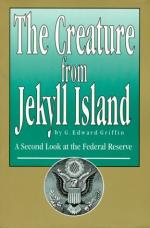
|
| Name: _________________________ | Period: ___________________ |
This quiz consists of 5 multiple choice and 5 short answer questions through Section IV. A Tale of Three Banks, Chapters 16-19 The Creature Comes to America; A Den of Vipers; Loaves and Fishes, and Civil War; Greenbacks and Other Crimes.
Multiple Choice Questions
1. In what year was First Pennsylvania Bank bailed out?
(a) First Pennsylvania Bank was bailed out in 1980.
(b) First Pennsylvania Bank was bailed out in 1972.
(c) First Pennsylvania Bank was bailed out in 1973.
(d) First Pennsylvania Bank was bailed out in 1975.
2. What occurred after the economic downturn in 1818?
(a) After the economic downturn in 1818, revenues were bolstered by increased taxation.
(b) After the economic downturn in 1818, layoffs and bankruptcies followed.
(c) After the economic downturn in 1818, loans were difficult to obtain.
(d) After the economic downturn in 1818, a period of deflation followed.
3. What event sparked the conflicts that led to World War I?
(a) World War I started in 1914 with the assassination of the Archduke of Austria-Hungary, Francis Ferdinand.
(b) World War I started in 1914 with the assassination of the Kaiser Wilhelm II of Germany.
(c) World War I started in 1914 with a global economic collapse.
(d) World War I started in 1914 with the intercession of the US into European affairs.
4. What unreasonable conclusion does the author make about the IMF and World Bank?
(a) The IMF and World Bank are operated by those with anti-American views.
(b) The IMF and World Bank are run by political operatives.
(c) Nothing the IMF or World Bank has done worked out successfully.
(d) The IMF and World Bank are corrupt organizations.
5. How did unemployment impact the economic problems?
(a) High employment made more homes available for sale.
(b) The Federal government was distracted from economic problems and focused their attention on the unemployed.
(c) High employment distracted people from looking for homes.
(d) High unemployment compounded this problem, forcing people into foreclosures and drying up the housing market.
Short Answer Questions
1. When did the American public become interested in socialism as an alternative to capitalism?
2. What did the author feel was the ultimate goal in establishing the IMF and the World Bank?
3. What is the status of a loan that is "underwater?"
4. Conspiracy theorists connected the potential of world socialism to what organization?
5. What monetary system did the Constitution of the newly formed United States require?
|
This section contains 621 words (approx. 3 pages at 300 words per page) |

|




